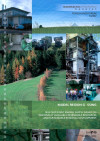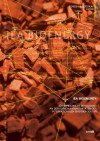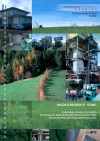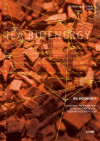Suchergebnisse
IEA Bioenergy Task 39: Biofuels to Decarbonize Transport (Working period 2022 - 2024)
The long-term goal of Task 39 is to drive decarbonisation in the transport sector using biogenic, sustainable, low-carbon fuels. This includes conventional and advanced biofuels that can be produced via different technological routes (oleochemical, biochemical, thermochemical and hybrid). In the 2022-2024 triennium, the focus was increasingly on long-haul transport, which is more difficult to electrify.
IEA Bioenergy Task 39: Biokraftstoffe zur Dekarbonisierung des Verkehrs (Arbeitsperiode 2022-2024)
Das langjährige Ziel von IEA Bioenergy Task 39 ist das Vorantreiben der Dekarbonisierung im Transportsektor mithilfe von biogenen, nachhaltigen Treibstoffen mit niedriger Kohlenstoffintensität. Dies schließt konventionelle und fortschrittliche Biokraftstoffe ein, die über verschiedene technologische Routen (oleochemische, biochemische, thermochemische und hybride) hergestellt werden können. Im Triennium 2022-2024 lag der Fokus zunehmend auf dem schwieriger zu elektrifizierenden Langstreckenverkehr.
IEA Bioenergy Task 39: Biokraftstoffe zur Dekarbonisierung des Verkehrs (Arbeitsperiode 2025)
IEA Bioenergy Task 39 ist ein Netzwerk internationaler Expert:innen, das die Dekarbonisierung des Verkehrs mithilfe nachhaltiger Biokraftstoffe vorantreiben möchte, wobei der Schwerpunkt auf dem Fernverkehrssektor (Flugverkehr, Schifffahrt, Schwerlastverkehr) liegt. Ziel der nationalen Arbeiten ist es, Informationen über den weltweiten technologischen und politischen Stand der Biotreibstoffe zu sammeln und zu analysieren und damit zur Entwicklung nachhaltiger, sozial- und umweltverträglicher Biotreibstoffsysteme beizutragen.
Maisgranulat zur Immobilisierung von Lipasen
Das Ziel des Projekts ist die Entwicklung einer neuen Methode zur Herstellung von Biodiesel und ähnlicher Verbindungen. Durch heterogene, enzymatische Katalyse ist es möglich, die Nachteile der herkömmlichen Biodieselproduktion auszuschließen. Lipasen werden, um das Preis-Leistungsverhältnis des Prozesses zu verbessern, auf unlöslichem Trägermaterial immobilisiert. Als neues Trägermaterial wird der kostengünstige und leicht zugängliche nachwachsende Rohstoff Maiskolbengranulat verwendet. Das Ziel des Projektes ist es, ein ökonomisches, gut funktionierendes, industriell anwendbares Verfahren für die Produktion von Estern niederer und höherer Alkohole zu entwickeln.
Berichte aus Energie- und Umweltforschung 3/2000 Highlights aus der Biomasseforschung III

Tagungsband der gleichnamigen Veranstaltung am 21. März 2000 in Wien
Energy-self-sufficient district Güssing
Development of a concept that shows the possibility of changing the energy supply of a district from fossil to 100% renewable energy carrier
Model region Güssing

Self-sufficient energy supply based on regionally available renewable resourcesand sustainable regional development
Forschungsforum
1/2007
Herausgeber: BMVIT
Englisch, 6 Seiten
Downloads zur Publikation
IEA Bioenergy

Österreichische Beteiligung an den Forschungsaktivitäten der internationalen Energieagentur
Forschungsforum
4/2000
Herausgeber: BMVIT
Deutsch, 6 Seiten
Downloads zur Publikation
Darstellung des effektiven Einsatzes innovativer Bioenergietechnologien im österreichischen Energiesystem der Zukunft (BioEff)
Die Studie zeigt Möglichkeiten und Strategien hinsichtlich des effektiven Einsatzes von innovativen Bioenergietechnologien in Österreich.
F&E-Strategie für Biotreibstoffe

Der österreichische Transportsektor hatte 2006 einen Endenergiebedarf von 353 PJ/a und emittierte mit 25 Mio. t CO2Äq etwa 25% der österreichischen Treibhausgase.
Presentation of the effective use of innovative bioenergy technologies in the Austrian energy system of the future (BioEff)
The study shows possibilities and strategies for the effective use of innovative bioenergy technologies in Austria.
Energie - Forschung und Entwicklung
Ausgaben der Öffentlichen Hand in Österreich, Erhebung 2006
Energieforschungserhebung 2013: Ausgaben der öffentlichen Hand in Österreich, Erhebung für die IEA

Die Mitgliedschaft Österreichs bei der Internationalen Energieagentur (IEA) verpflichtet Österreich zur jährlichen Erfassung aller öffentlich geförderten F&E-Projekte. Die Energieforschungserhebung ist ein wichtiges Instrument, um Entwicklungen im Bereich der Energietechnologien zu verfolgen und entsprechende FTI-politische Maßnahmen zu setzen.
Mehrsprachig
Modellregion Güssing

Energieautarkie auf Basis regionaler erneuerbarer Ressourcen und nachhaltige Regionalentwicklung
Forschungsforum
1/2007
Herausgeber: BMVIT
Deutsch, 6 Seiten
Downloads zur Publikation
Berichte aus Energie- und Umweltforschung 3/1998 Altspeiseölmethylester Erprobung als Biodiesel

Wissenschaftliche Grundlagen zur Qualitätsbeurteilung von Altspeiseölmethylester und seine Erprobung als Dieselkraftstoff
Energieforschungserhebung 2010

Energie - Forschung und Entwicklung: Ausgaben der öffentlichen Hand in Österreich 2010
Energieforschungserhebung 2005

Ausgaben der öffentlichen Hand in Österreich - Erhebung für die IEA
IEA Bioenergy

Austrian Participation in an international Research Cooperation
Forschungsforum
4/2000
Herausgeber: BMVIT
Englisch, 6 Seiten
Downloads zur Publikation
Energieforschungserhebung 2007

Ausgaben der öffentlichen Hand in Österreich Erhebung für die IEA
Wirtschaftlichkeits- und CO2-Bewertung ausgewählter biomassebasierter Energieträger für Österreich (BIOWERT)
Beitrag zur Dekarbonisierung 2040
